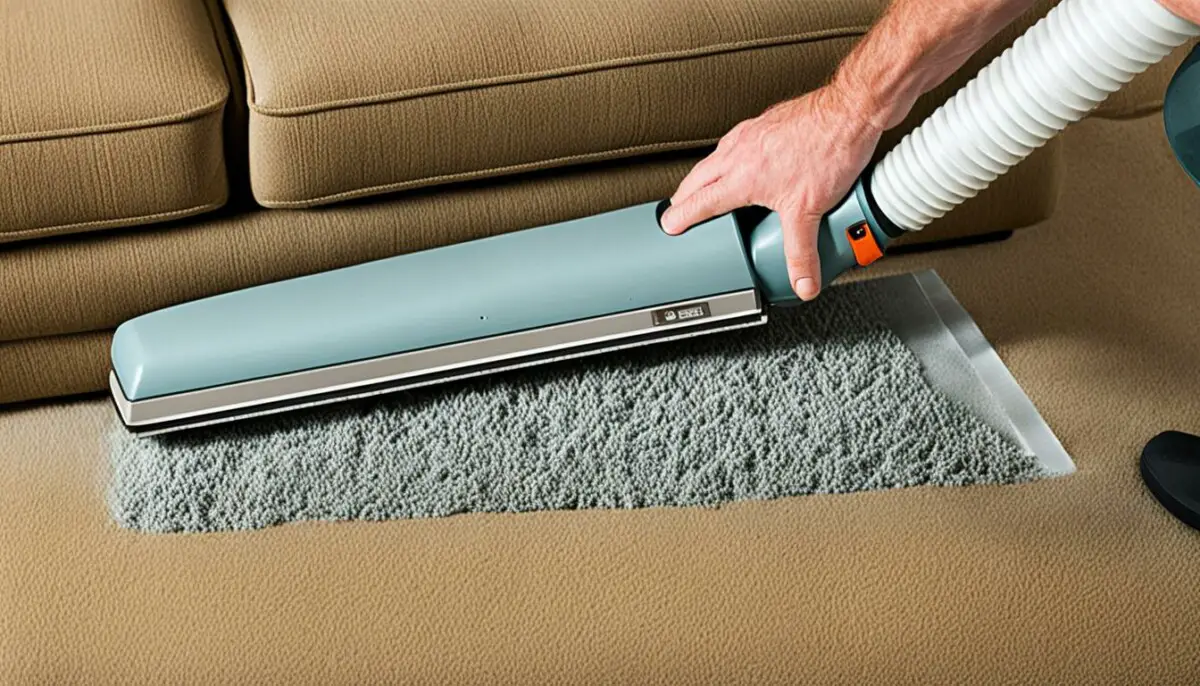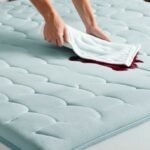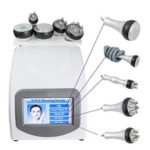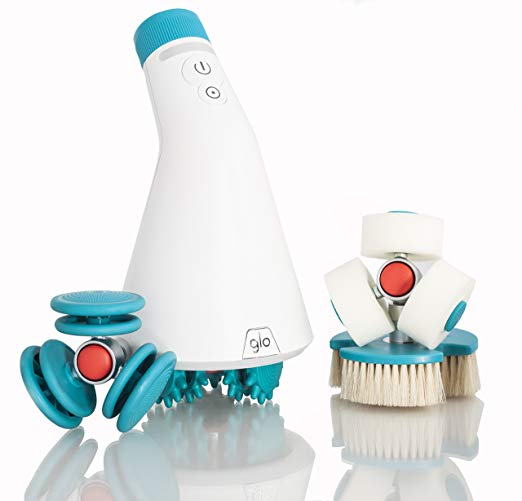Last Updated on 3 months by Francis
The bottom of a couch is often overlooked when it comes to cleaning and maintenance. However, giving attention to the underside of your couch is just as important as caring for the visible parts. The couch base collects dirt, crumbs, and stains over time, which can affect the overall cleanliness and durability of the couch. To ensure the longevity and cleanliness of your couch, it’s essential to know how to properly care for the bottom.
Contents
Key Takeaways:
- Regularly clean and maintain the bottom of your couch to ensure its cleanliness and durability.
- Check the care tag for specific cleaning instructions.
- Understand the upholstery cleaning codes to determine the appropriate cleaning method.
- Follow the right cleaning techniques for fabric, microfiber, and leather couches.
- Use baking soda or fabric sprays to eliminate odors from couch fabric.
- Utilize lint rollers and handheld vacuums for quick cleaning.
- Consider the benefits of professional couch cleaning for thorough maintenance.
Understanding Upholstery Cleaning Codes

Before cleaning your couch, it is important to check the care tag for specific instructions on how to clean the fabric. Upholstery cleaning codes are indicated on the tag, providing valuable information on the appropriate cleaning method and products to use. Understanding these codes will help you maintain the integrity of your couch and ensure effective cleaning.
The care tag is usually located on the underside of the couch or on one of the cushions. Look for the fabric cleaning codes that typically consist of one or two letters. Here are the common codes and their meanings:
| Code | Cleaning Method |
|---|---|
| W | Water-Based Cleaners |
| S | Solvent-Based Cleaners |
| X | Vacuum Only |
To determine which cleaning method is safe for your couch, refer to the corresponding code. If your couch has a code “W,” it indicates that water-based cleaners can be used. For couches with a code “S,” solvent-based cleaners are suitable. On the other hand, if your couch has the code “X,” it means vacuuming is the only recommended cleaning method to avoid damaging the fabric.
Using the wrong cleaning agent or method can lead to discoloration, shrinkage, or other irreversible damage. It is vital to follow the fabric cleaning codes to ensure the longevity and appearance of your couch.
Choosing the Right Cleaning Products
Once you understand the upholstery cleaning codes, it’s essential to select the appropriate cleaning products. Water-based cleaners are typically mild and gentle on most fabrics, while solvent-based cleaners are more effective for deep stains and stubborn dirt. Make sure to read the labels of cleaning products to ensure they align with the code on your couch’s care tag.
For water-based cleaning, consider using mild detergent or upholstery cleaner specifically formulated for fabric sofas. On the other hand, solvent-based cleaners may include dry cleaning solvents or stain-removing sprays. Be cautious when choosing solvent-based cleaners and follow the instructions carefully to avoid any potential damage to the fabric.
Always conduct a patch test on a small, inconspicuous area of the couch before applying any cleaning product to the entire upholstery. This test will help you determine if the product causes any discoloration or adverse reactions.
Remember, understanding the upholstery cleaning codes allows you to make informed decisions about the suitable cleaning method and products for your couch fabric. Following the proper cleaning guidelines will help you maintain a clean and fresh-looking couch for years to come.
Cleaning Fabric and Microfiber Couches
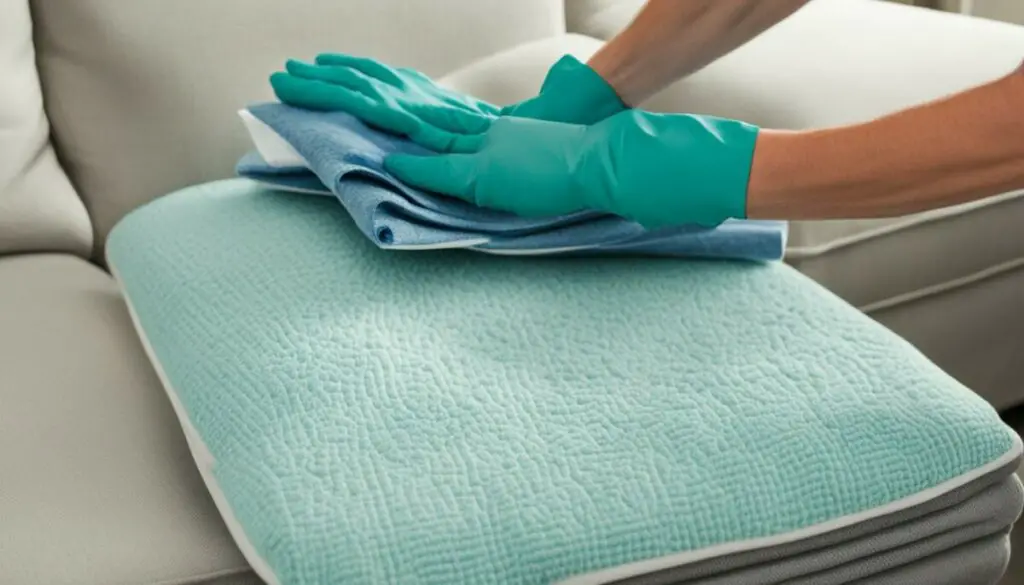
When it comes to maintaining the cleanliness of your fabric and microfiber couches, a deep clean is essential. By following a few simple steps, you can ensure that your couch remains fresh and spotless for years to come.
Step 1: Steaming and Vacuuming
Start by steaming the surface of your couch to kill surface dust mites. This step helps eliminate allergens and ensures a thorough clean. Use a handheld steam cleaner or a garment steamer and run it over the entire upholstery, paying special attention to any stained or soiled areas.
After steaming, it’s time to vacuum the upholstery. Use a vacuum cleaner with an upholstery attachment and thoroughly clean the entire couch, including the crevices, seams, and cushions. Vacuuming helps remove dust, debris, and loose dirt from the fabric, preparing it for the next steps.
Step 2: Spot Cleaning
Spot cleaning is essential for tackling stains and spills on your fabric and microfiber couches. Identify any stains or soiled areas on the upholstery and apply a suitable cleaning solution. Be sure to test the solution on a small, inconspicuous area of the fabric before applying it to the stain directly.
Follow the instructions on the cleaning solution and gently blot the stain using a clean cloth or sponge. Avoid rubbing the fabric vigorously as it may cause damage. Continue blotting until the stain is removed or significantly lightened.
Step 3: Sanitizing
Sanitizing your couch is the final step to ensure a deep clean. Use a fabric sanitizing spray that is safe for your specific fabric type. Spray the entire upholstery, focusing on areas that are frequently used or prone to bacteria buildup.
Allow the sanitizing spray to dry completely before using your couch again. This step helps eliminate any remaining bacteria, odors, or allergens, leaving your fabric and microfiber couch fresh and sanitized.
By following these steps, you can effectively clean and maintain the fabric and microfiber couches in your home. Regular deep cleaning, spot cleaning, and sanitizing will not only keep your couch looking its best but also contribute to a healthier living environment for you and your family.
Cleaning a Leather Couch

Cleaning a leather couch requires routine maintenance to keep it looking its best. Follow these steps to ensure your leather couch stays clean and protected:
1. Wiping Away Surface Dirt
Start by wiping the fabric of your leather couch with a microfiber cloth. This will help remove crumbs, dirt, and dust that can accumulate over time. Be sure to focus on areas where dirt tends to collect, such as armrests and seat cushions.
2. Vacuuming for a Deep Clean
Next, use a vacuum cleaner with a crevice tool attachment to vacuum the couch. This will help remove dirt and debris from hard-to-reach areas, such as between cushions and along seams. Vacuuming regularly will prevent dirt from settling into the leather, extending the lifespan of your couch.
3. Gentle Cleaning with a Leather Cleaner
To deep clean the leather surface, use a leather cleaner or a mild soap solution. Apply the cleaner to a soft cloth and gently wipe the entire couch, focusing on any stains or spills. Avoid using excessive water or soaking the leather, as this can damage it. Rinse the cloth with clean water and wipe away any soap residue.
4. Rinse and Condition
After cleaning, rinse the cloth with clean water and dampen it. Use the damp cloth to wipe the couch, removing any remaining soap residue. This will prevent the leather from becoming sticky or attracting more dirt. Once the surface is clean, apply a leather protectant or conditioner to maintain its natural moisture and prevent future stains.
| Materials: | Instructions: |
|---|---|
| Microfiber cloth | 1. Wipe the fabric to remove dirt and dust. |
| Crevice tool attachment for vacuum cleaner | 2. Vacuum the couch, paying attention to hard-to-reach areas. |
| Leather cleaner or mild soap solution | 3. Gently clean the leather surface, focusing on stains and spills. |
| Soft cloth and clean water | 4. Rinse the surface to remove any soap residue. |
| Leather protectant or conditioner | 5. Apply a protectant to condition and protect the leather. |
Regular cleaning and maintenance of your leather couch will help preserve its appearance and durability. By following these steps, you can ensure that your leather couch remains a beautiful and long-lasting centerpiece in your living room.
Removing Odors from Couch Fabric
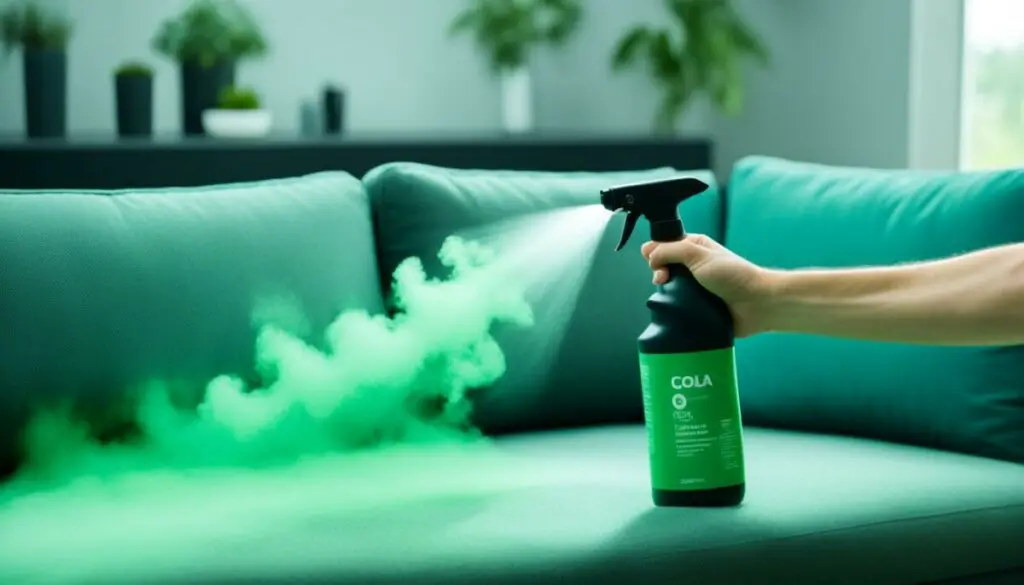
Couch fabric can accumulate odors over time, causing your living room to smell less than fresh. To keep your couch smelling clean and eliminate odors, you can try a few simple techniques.
Freshen up with Baking Soda
One easy and effective method to eliminate odors from your couch is by using baking soda. Baking soda is a natural deodorizer that absorbs unpleasant smells. Simply sprinkle baking soda all over the fabric, ensuring even coverage. Let it sit for at least 15 minutes to allow the baking soda to neutralize and absorb the odors. Afterward, vacuum the baking soda off the couch using the brush attachment.
If you prefer a ready-to-use solution, fabric sprays specifically designed to remove odors can be an excellent option. These sprays are formulated to eliminate odors and freshen up the fabric without leaving any residue behind. Simply spray the fabric spray evenly across the surface of the couch, focusing on areas where odors are strongest. Allow the fabric spray to dry completely.
Both baking soda and fabric sprays work by eliminating odors instead of just masking them, leaving your couch smelling fresh and clean.
Did You Know?
Aside from eliminating odors, baking soda can also help remove stains from couch fabric. Mix baking soda with water to create a paste and apply it to the stained area. Gently scrub the paste into the fabric using a soft brush, then rinse with water and allow it to air dry.
Preventing Odors
To prevent odors from building up on your couch fabric, consider implementing the following measures:
- Vacuum your couch regularly to remove dust, crumbs, and other debris.
- Keep pets off the couch or use a washable cover to protect the fabric from pet odors.
- Avoid eating or drinking on the couch to minimize spills and food-related odors.
- Allow proper ventilation in the room to prevent trapped odors.
By adopting these prevention strategies and incorporating regular odor removal techniques, you can ensure that your couch remains fresh and inviting.
Quick Tips for Couch Cleaning
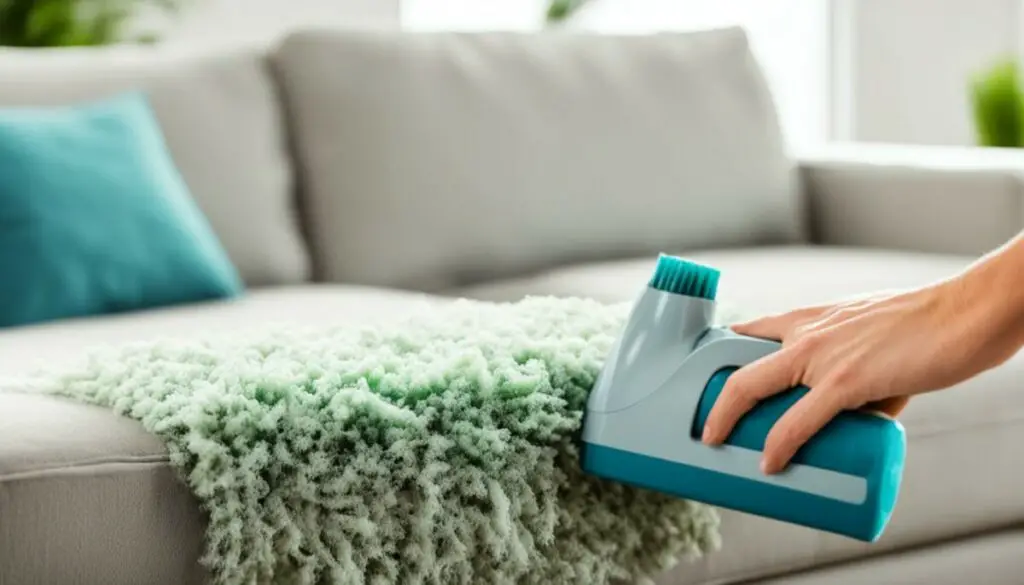
When it comes to keeping your couch clean, there are a few quick tips that can make a big difference. Whether you’re dealing with small debris, pet hair, or tough stains, these tips will help you maintain a fresh and inviting couch.
Lint Roller: For quick cleaning of small debris like crumbs or lint, a lint roller is a convenient tool to have on hand. Simply roll it over the fabric to pick up any loose particles.
Handheld Vacuum: When dealing with larger amounts of pet hair or crumbs, a handheld vacuum can be your best friend. Its compact size and powerful suction make it perfect for cleaning up messes quickly and efficiently.
Professional Cleaning: While lint rollers and handheld vacuums are great for regular maintenance, there are times when you’ll need to call in the professionals. Deep stains and embedded dirt often require the expertise and specialized equipment of a professional upholstery cleaner. They have the knowledge and experience to tackle tough stains and restore your couch to its former glory.
Remember, a clean couch not only looks great but also contributes to a healthier living environment. Regular maintenance with a lint roller and handheld vacuum can go a long way, but don’t hesitate to seek professional cleaning when needed.
Benefits of Professional Couch Cleaning
Hiring a professional couch cleaning service offers numerous benefits, ensuring the cleanliness and longevity of your furniture.
Removal of Dust Mites, Allergens, and Pet Dander
The presence of dust mites, allergens, and pet dander in your couch can negatively impact the air quality in your home. Professional cleaners have the expertise and specialized equipment to effectively eliminate these contaminants, providing a healthier environment for you and your family.
Extended Furniture Lifespan
Regular professional cleaning helps maintain the integrity and durability of your couch, extending its lifespan. By removing dirt, stains, and other particles that can cause fabric deterioration and damage, you can enjoy your couch for longer without the need for costly repairs or replacements.
Tackling Tough Stains and Odors
Professional upholstery cleaners possess the knowledge and tools to tackle even the toughest stains and odors on your couch. Whether it’s stubborn wine spills or lingering pet odors, these experts employ effective cleaning methods and products to restore your couch to its original condition.
Convenience and Time Savings
Hiring professionals to clean your couch saves you time and effort. Instead of spending hours scrubbing and vacuuming, you can leave the task to experienced cleaners who will efficiently and effectively rejuvenate your couch. Sit back, relax, and let the experts take care of the cleaning process.
Summary:
Professional couch cleaning offers numerous benefits, including the removal of dust mites, allergens, and pet dander, extended furniture lifespan, effective stain and odor removal, and the convenience of saving time and effort. Trusting professionals with your couch ensures a clean and fresh living environment, preserving the beauty and comfort of your furniture for years to come.
How to Clean Different Types of Couches
Cleaning different types of couches requires specific techniques. Here are some methods for cleaning different upholstery materials:
Cloth Couch
For cloth couches, start by gently brushing the fabric to remove any loose particles. Then, sprinkle baking soda on the surface and let it sit for 15-20 minutes to absorb odors. After that, vacuum the couch thoroughly to remove the baking soda. You can also create a DIY cleaning solution using mild dish soap and water. Apply the solution to a clean cloth and blot any stains gently. Be careful not to soak the fabric. Finally, let the couch air dry.
Microfiber Couch
When cleaning a microfiber couch, you can use rubbing alcohol or distilled water. Fill a spray bottle with rubbing alcohol or distilled water and lightly mist the stained areas. Use a clean cloth or sponge to gently blot the stains. Avoid rubbing vigorously as it may damage the fabric. Allow the couch to air dry.
Suede Couch
Cleaning a suede couch requires extra care. Begin by using a soft, dry cloth or suede brush to gently brush the surface and remove any loose dirt or debris. For stains, use a damp cloth with a small amount of gentle suede cleanser or vinegar-water solution. Blot the stain gently, without rubbing vigorously. After cleaning, let the suede couch air dry naturally.
VelveT Couch
Velvet couches require regular vacuuming using an upholstery attachment to remove dust, dirt, and pet hair. If you notice any stains, gently blot them with a clean cloth and mild water-based cleaning solution. Avoid using excessive water or rubbing vigorously as it may damage the fabric. Allow the couch to air dry completely before using it again.
Couch Cushions
To clean couch cushions, start by removing the covers if possible and follow the appropriate cleaning method for the specific upholstery material. For spot cleaning, use a mild detergent or stain remover according to the care instructions. To deep clean the entire cushion, you can either hand wash them or use a washing machine if the care instructions allow it. Be sure to let the cushions air dry completely before placing them back on the couch.
By using the proper cleaning techniques for each type of couch upholstery, you can keep your furniture looking fresh and extend its lifespan. Regular maintenance and cleaning will help your couch stay comfortable and inviting for years to come.
Conclusion
Taking care of your couch is crucial for maintaining its cleanliness and longevity. By following the tips and techniques provided in this article, you can ensure that your couch remains in good condition for years to come. Regular couch cleaning, proper maintenance, and cleanliness practices will keep your couch looking fresh and inviting.
Start by regularly vacuuming your couch to remove dust, crumbs, and pet hair. Spot clean any spills or stains immediately to prevent them from setting in. Additionally, deep clean your couch periodically using appropriate cleaning solutions and techniques suited to the fabric type.
Remember to always check the care tag and follow the guidelines provided by the manufacturer. This will help you choose the right cleaning products and avoid any potential damage to your couch. Investing time in proper couch cleaning and maintenance will pay off in the long run, as it will keep your couch looking and feeling its best for years to come.
FAQ
Why is it important to clean the bottom of a couch?
The bottom of a couch often accumulates dirt, crumbs, and stains over time, which can affect the overall cleanliness and durability of the couch.
How can I determine the appropriate cleaning method for my couch?
Check the care tag on your couch for specific instructions. Upholstery cleaning codes, such as “W” for water-based cleaners, “S” for solvent-based cleaners, and “X” for vacuuming only, will guide you in choosing the right cleaning method.
How do I deep clean fabric and microfiber couches?
Start by steaming the surface to kill surface dust mites. Then, vacuum the upholstery thoroughly, including the crevices and seams. Spot clean stains using appropriate cleaning solutions, and sanitize the couch using a fabric sanitizing spray.
What is the proper way to clean a leather couch?
Wipe the fabric with a microfiber cloth to remove crumbs and dirt. Vacuum the couch using a crevice tool to reach tight spots. Use a leather cleaner or mild soap solution to gently clean the surface, and rinse with a damp cloth. Apply a protectant to condition the leather and prevent future stains.
How can I remove odors from my couch fabric?
To freshen up your couch and eliminate odors, sprinkle baking soda all over the fabric or use a fabric spray designed to remove odors. These products work by eliminating odors instead of just masking them, leaving your couch smelling clean and fresh.
What tools are useful for quick couch cleaning?
A lint roller is convenient for cleaning small debris, while a handheld vacuum is perfect for larger amounts of pet hair or crumbs. For deep stains and professional cleaning, it is recommended to seek the services of a professional upholstery cleaner.
What are the benefits of hiring a professional couch cleaning service?
Professional cleaning helps remove dust mites, allergens, and pet dander that can affect the air quality in your home. It also extends the lifespan of your furniture by maintaining its integrity and durability. Professionals have the expertise and specialized equipment to tackle tough stains and odors, while saving you time and effort.
How should I clean different types of couches?
Cloth couches can be brushed, have baking soda applied, or be cleaned with a DIY cleaning solution. Microfiber couches can be cleaned with rubbing alcohol or distilled water. Suede couches require gentle cleaning with a damp cloth or suede-specific products. Velvet couches need to be vacuumed and treated for stains. Cleaning couch cushions involves spot cleaning and overall upholstery cleaning techniques.
How can I take care of the bottom of my couch?
Regular vacuuming, spot cleaning, and deep cleaning will keep the bottom of your couch looking fresh and inviting. Always check the care tag and use appropriate cleaning products for your specific couch fabric.

